If I had to pick a favorite houseplant family, I think I’d choose calathea. Their colorful leaves come in all sorts of shapes and sizes, so you’ll never get bored with adding to a calathea collection!
Calathea plants are a genus of plants from the family marantaceae, putting them in the same family as prayer plants. They are known for their beautiful foliage, which folds up at night and unfurls in the morning. The leaves are often striped or otherwise patterned on top, and purple or maroon underneath. Calathea plants have a bit of a reputation as divas, but once you know how to meet their needs, they are actually not too difficult to take care of. Let’s talk about calathea care!
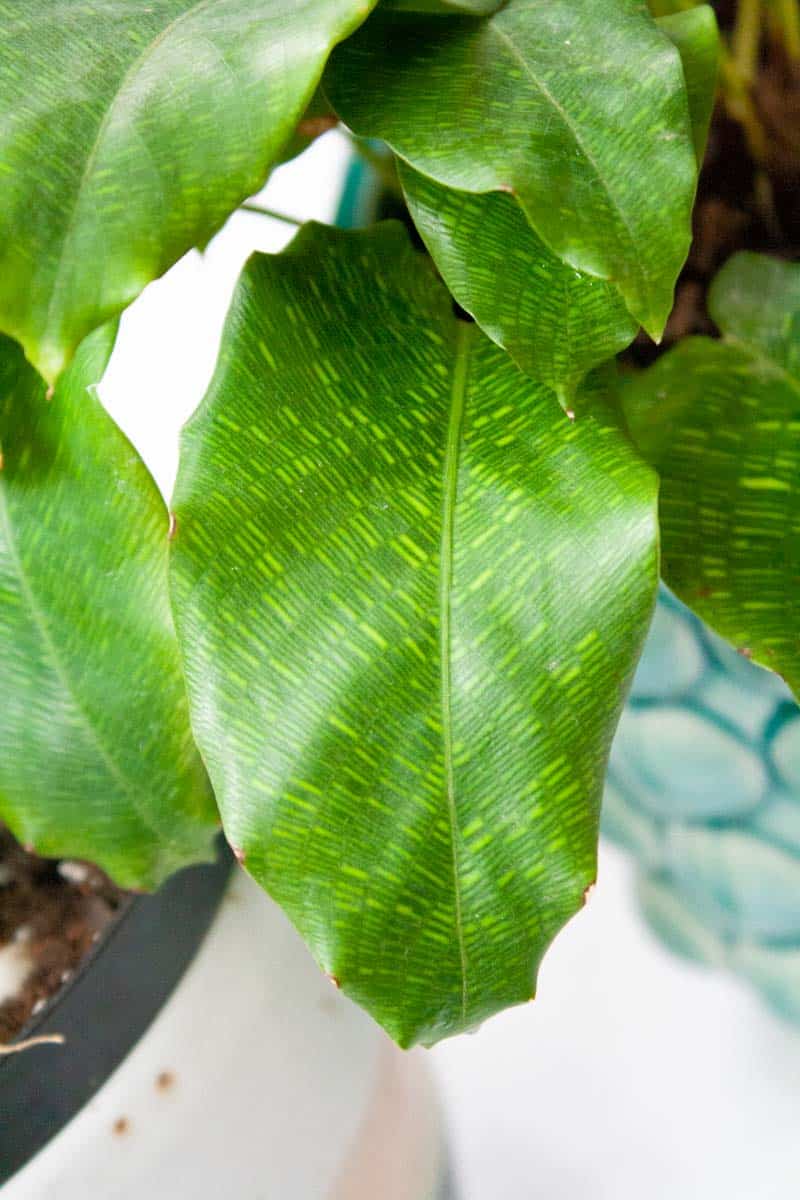
Table of Contents
Calathea care: light
Houseplants tend to thrive the most when you can replicate their natural environments as closely as possible. In their natural habitat, calathea grow on the rainforest floor, where they receive the sunlight that filters down through the trees above them. Because of this, they aren’t made for bright, direct light—it’s too intense for them. In too much direct sun, calathea foliage loses its colors, and the leaves may burn.
Instead, calathea thrive in medium, indirect light. Try them in an unobstructed east or west-facing window, or a south-facing window where the light is diffused by a sheer curtain or outdoor trees. They can handle low light, but their growth will be much slower than in medium light.
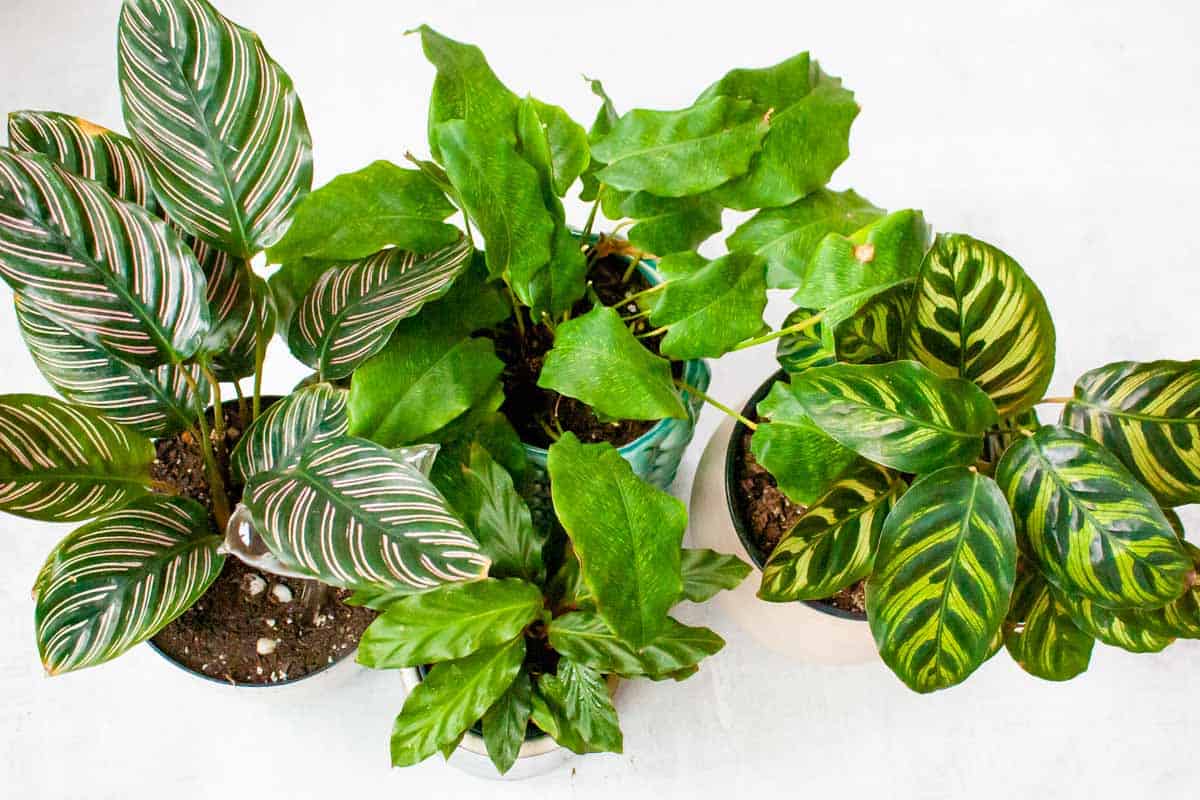
Calathea water needs
Calathea plants need soil that is consistently moist, but not soggy. This means they will likely need to be watered more often than many of your other plants. Water when the top one inch of soil is dry, and then water thoroughly. Do make sure that your pot has a drainage hole in the bottom, so that water doesn’t get trapped on the roots and lead to root rot.
They are also a great candidate for self-watering bulbs, which allows water to be consistently dribbled right to the roots of the plant.
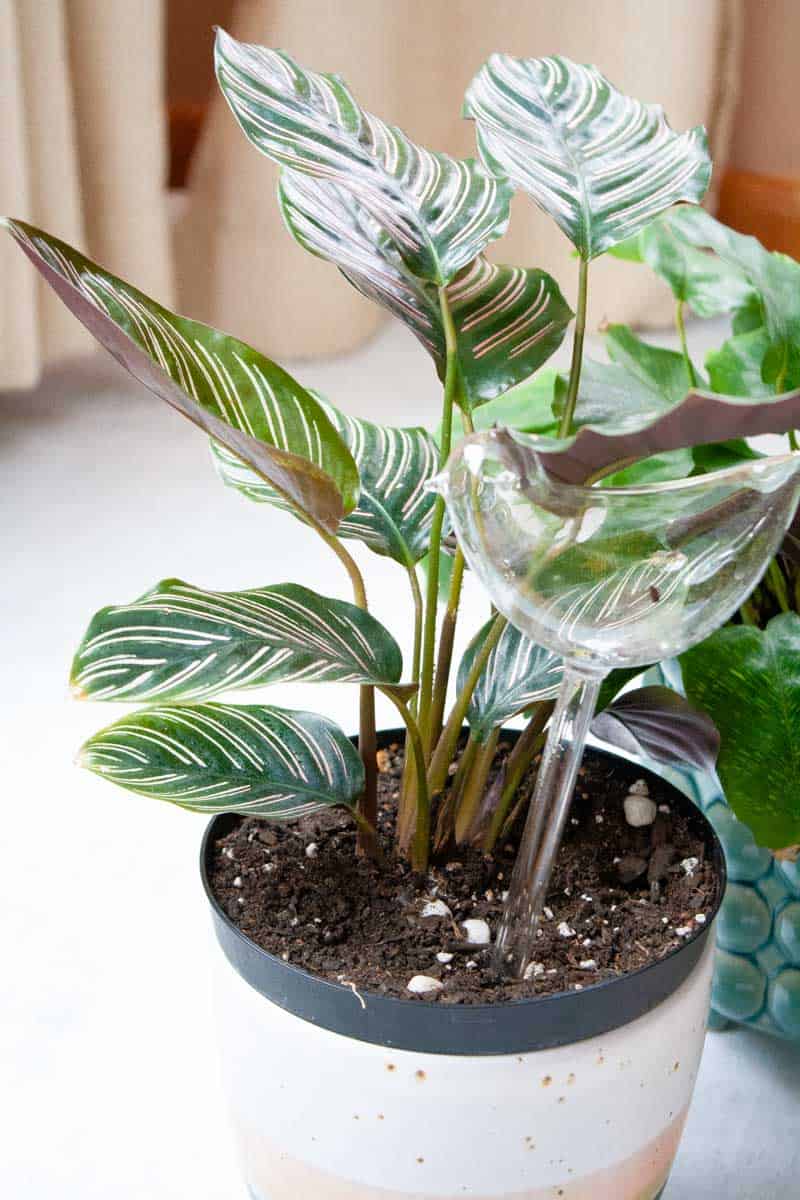
Calathea are often seen as a fussy plant, and part of that is because they can be very sensitive to the quality of their water. Hard water, fluoridated water (this is most tap water in the United States), and soft water can all lead to leaf burn and brown leaf edges. Your calathea plants will be much happier with distilled water, collected rainwater or snow melt, or filtered tap water that has been let to sit on the counter for at least 24 hours before use.
Growfully Protip
Calathea can be sensitive to chlorine in their water. Allowing filtered tap water to sit on the counter for a day will naturally dechlorinate the water.
Humidity requirements for calathea care
This is where the second part of calathea’s reputation as a diva plant comes from—because they are tropical plants, calathea thrive in high humidity, higher than most of us have in our homes, especially in the winter. But there are some simple ways to improve the humidity around your plants:
- Group plants together. Clustering plants together is a simple and free way to raise the humidity around your plants. Plants are always releasing water vapor via a process called transpiration, so by keeping your plants close together, they can lend each other their moisture and humidity.
- Put a pebble tray near your plants. Fill a shallow tray with pebbles or small rocks, and fill the tray about halfway up the rocks with water. Place the pot of your calathea on top of the pebbles. As the water slowly evaporates from the tray, your calathea will get a boost of humidity.

Growfully Protip
When filling your pebble tray with water, make sure that the pot isn’t sitting directly in the water, and that the pebbles keep the plant well above the water line. Otherwise, your plant will suck up the water via its roots, and be prone to root rot.
- Use a humidifier. A small humidifier pointed towards your plants is an obvious way to raise the humidity.
- Mist your plants. This doesn’t actually raise the humidity that much, but it is a peaceful, satisfying way to give your plants some love every week.
- Keep the calathea plants away from vents and drafty windows. Air from air conditioning vents, heating vents, and cold drafts can dry out the soil and suck the humidity out of the air. Keep your plants out of their direct path.
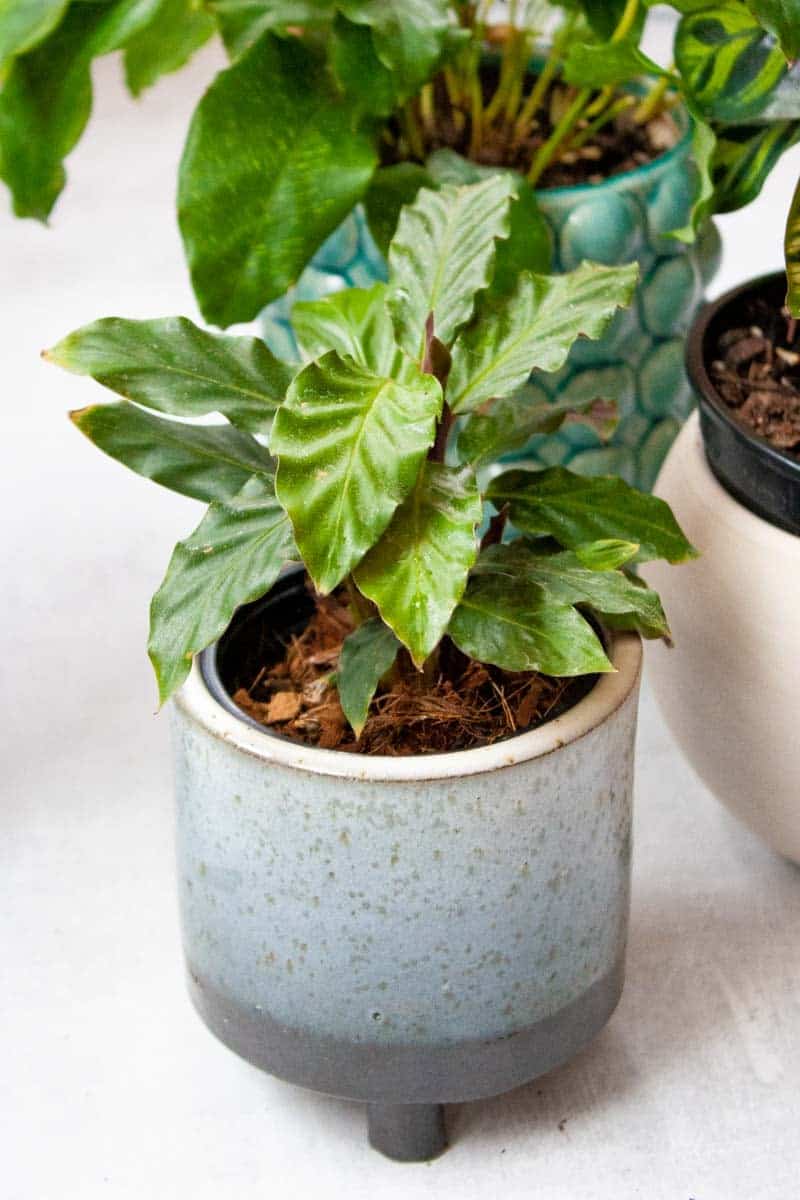
Potting medium for calathea
For calathea, you want a soil that will retain water but also drain well. I’ve had calathea thrive with both an African violet soil mix, and a generic organic potting mix that I aerate often. The aeration loosens up the soil so that air and water can circulate and reach the roots better, and all you need is a wooden chopstick!
To aerate, just poke holes in the surface of the soil with the chopstick. Now, water will be distributed much more evenly throughout your soil, reaching all parts of the roots.
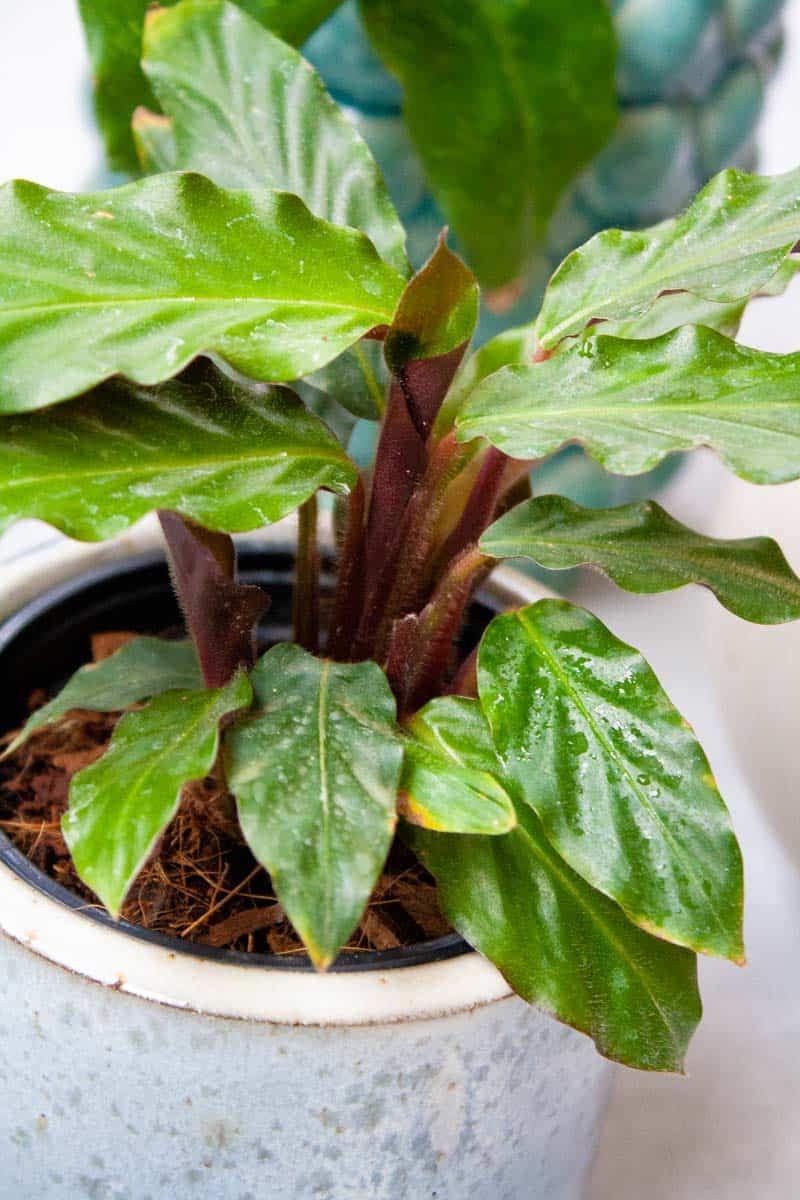
Fertilizing calathea
Calathea only need fertilizer when they are actively growing. New leaves will first appear as tightly rolled vertical scrolls, which will then slowly unfurl.
If you aren’t seeing new leaves pop up (which is common in places with colder winters), the plant is probably in its dormant phase, and you don’t need to fertilize. In the spring, summer, and fall, feed with a diluted fertilizer every 4-8 weeks, depending on how fast your plant is growing.
Temperature
Calathea like things warm, so keep them away from cold drafts and the direct path of air conditioning vents. But don’t let them get too hot, or the leaves will start to curl. A temperature of 65-80 or 85°F is optimal.
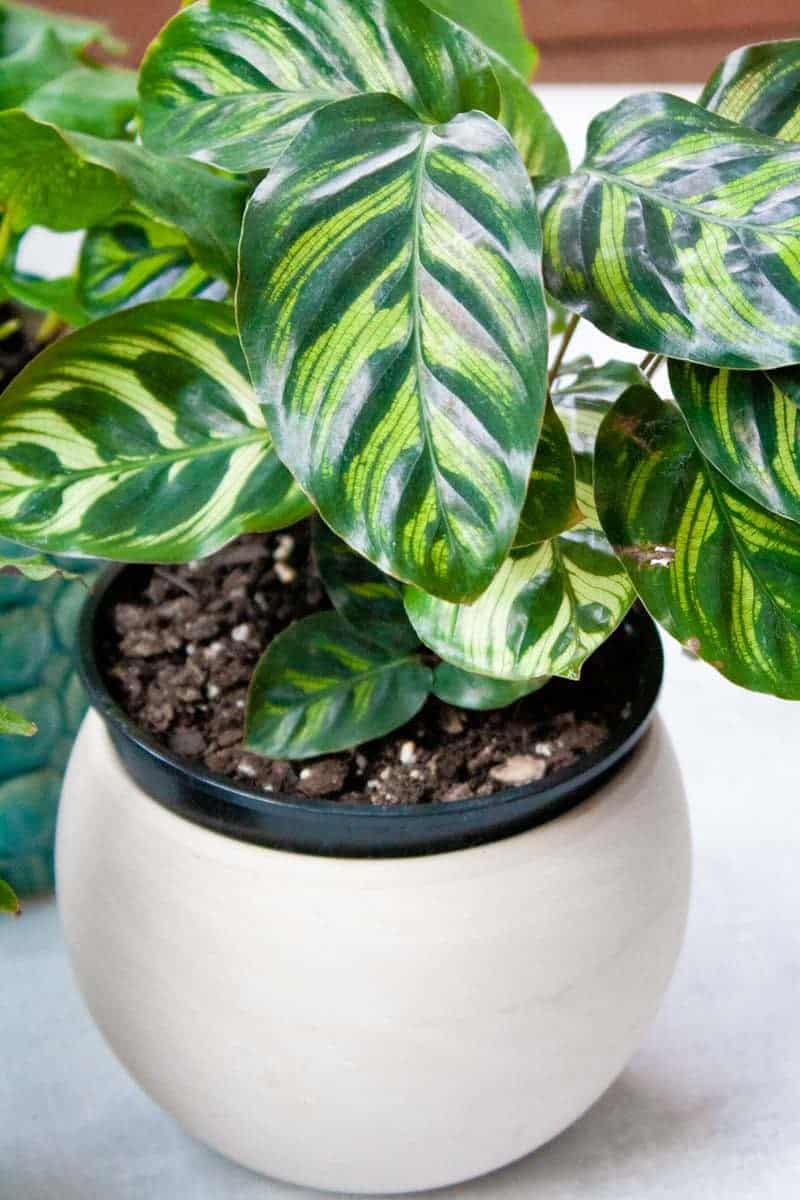
Should I mist my calathea?
Misting plant leaves is commonly cited as a way to increase the humidity around a plant, but it doesn’t actually make a big difference to the humidity. However, it does give the calathea a little, temporary humidity boost, and can be an immensely satisfying activity. It can also deter pests or knock off any bugs that are trying to make a home in your calathea. So if misting your calathea soothes you, mist on!
If you choose to mist your calathea, spritz from below the plant, so that the water stays on the undersides of the leaves.
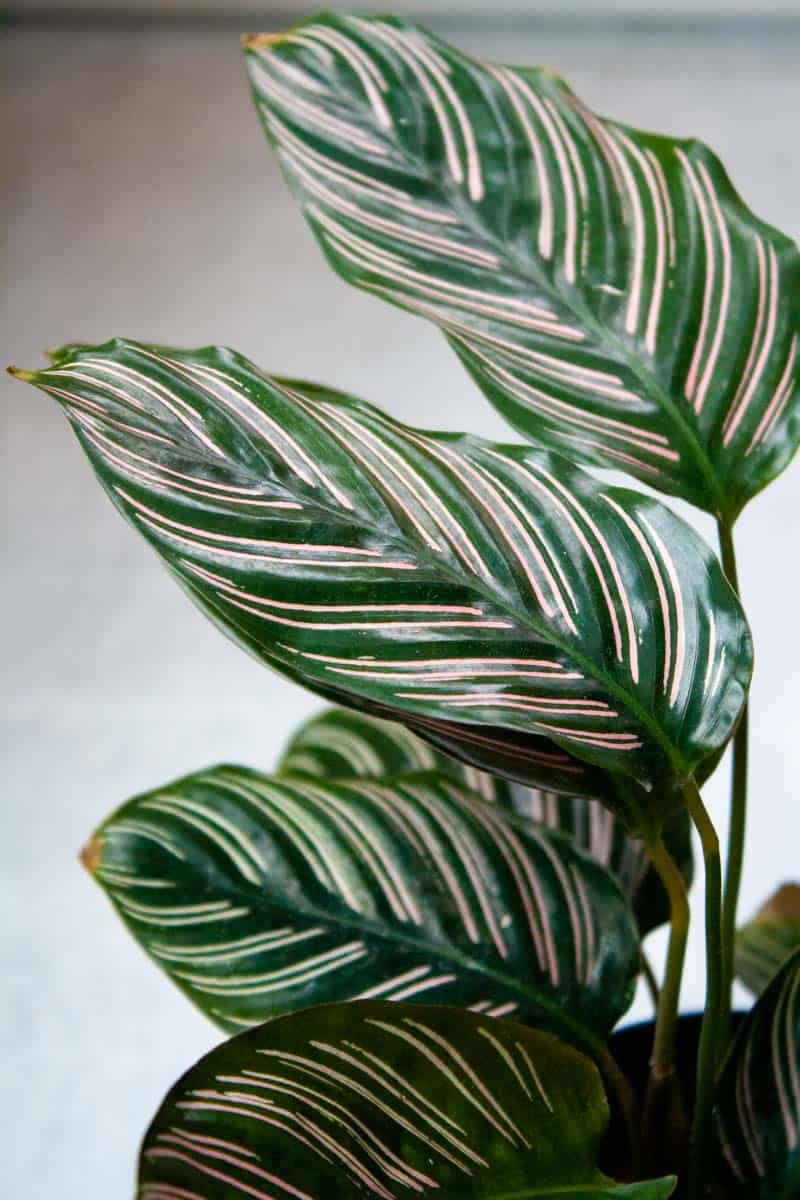
Is calathea a low light plant?
Calathea can generally tolerate fairly low light, but I wouldn’t go sticking them in a windowless corner. They are used to receiving medium amounts of bright indirect light, so make sure they can still see some sunlight for at least part of the day!
Growfully Protip
While calathea can tolerate low light, they will grow significantly slower than they will in bright indirect light.
How often should you water a calathea?
Water your calathea plants when the top inch of soil is dry. Stick your finger into the soil about an inch deep—if your finger comes out relatively clean, it’s time to water. If there is soil sticking to your finger, wait another day or two and check again!

Why do calathea leaves close at night?
One of my favorite things about calathea is how they respond to light throughout the day—at night, when darkness sets in, the calathea fold up their leaves, showing off their purple and maroon undersides. When daylight returns, the plant stretches its leaves back out, so the leaves can take in as much sunlight as possible, and you can see the pattern on the tops of the leaves.
When should I repot my calathea?
Calathea shouldn’t need to be repotted all that often—you’ll mostly want to look for signs that they are getting root bound. If you see roots poking out from the drainage hole, it’s time to check the roots. Supporting the plant with one hand, use the other to gently tip the plant out of its pot, and inspect the roots. If they are winding and compacted in the shape of the pot, with hardly any soil around the bottom of the roots, it’s time for repotting. Size up your pot, add some fresh soil, and give your calathea a good drink to help it settle in to its new home.
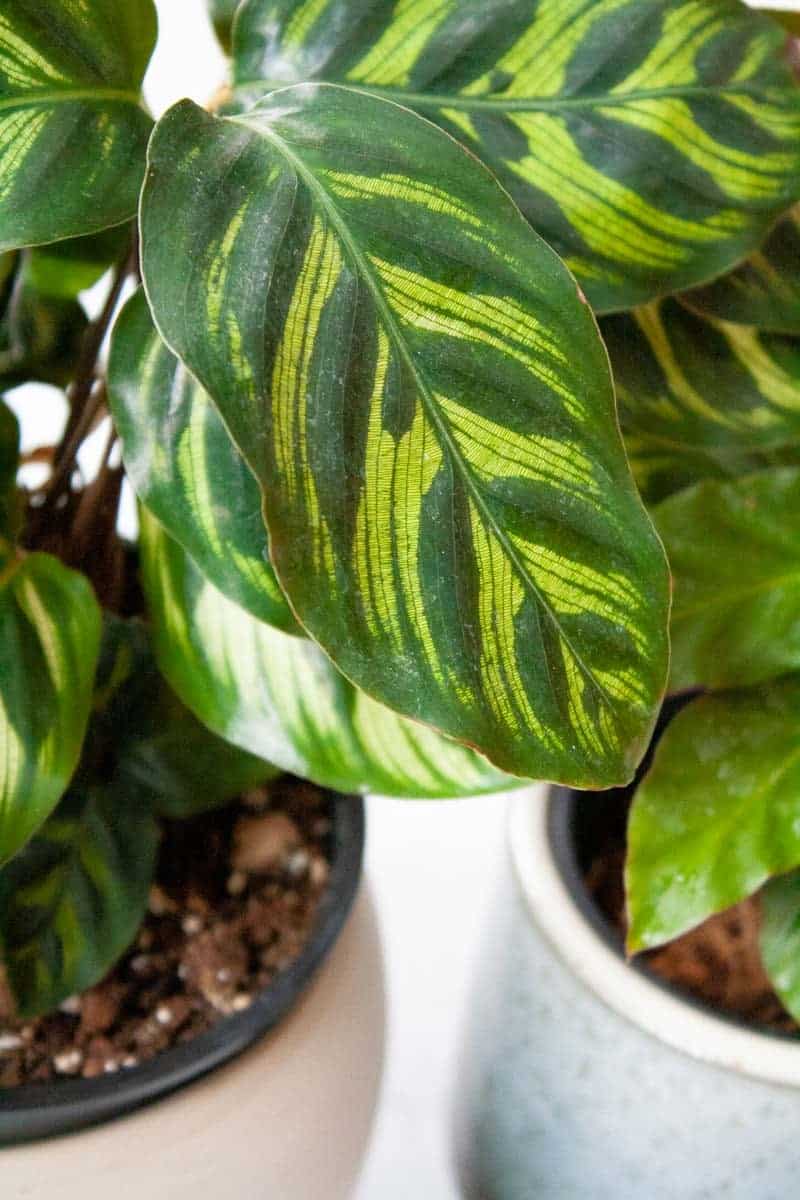
Where can I buy calathea plants?
If you’re ready to buy a calathea, get yourself to a local nursery—most nurseries will carry at least 1 or 2 varieties of calathea. Facebook Marketplace and local plant trading groups on Facebook can be a great source of affordable plants, too.
There are dozens of kinds of calathea to choose from. Some of our favorite, more unique calathea varieties that you might want to look for include:

- Calathea Ornata. This calathea, also referred to as a Pinstripe Calathea, has dark green leaves with the palest pink stripes. This was one of my first plants, and so far, nothing has replaced it as my absolute favorite.
- Calathea Lancifolia. More commonly known as a rattlesnake plant, this variety has thin, wavy leaves with dark green spots and vibrant maroon undersides.
- Calathea Makoyana. This is one of the most intricately decorated types of calathea—the leaves are light green and patterned with very thin lines, interspersed with larger dark green ovals.They look almost like feathers, which is why this calathea is also called a peacock plant.
- Calathea Musaica. This one gets its common name, Network Calathea, from the intricate patterns of thin lines that cover the leaves.
- Calathea Roseopicta. These calathea have broad, rounded leaves. The “Medallion calathea” plant is a classic, with dark green leaves. But you can also look for the “Dottie” variety, which has deep purple—almost black—leaves with bright pink patterns.
- Calathea Rufibarba. The leaves of this calathea truly feel like velvet. They are so fuzzy and soft!
Growfully Protip
As tempting as it is, if you live in a place with very cold winters, try to avoid ordering calathea plants online in the depths of winter. Calathea can be sensitive plants, and heat packs are no match for a polar vortex. Ask the seller if they can wait to ship until spring, or hold off on ordering until then!
Are calathea plants toxic?
The ASPCA does not consider calathea plants to be toxic to cats, dogs, or horses.

Troubleshooting
Help, the foliage is losing color and looks faded!
Generally, this is a sign that your calathea is receiving too much direct sunlight. Try moving the plant away from the window a bit, or to a window that faces east or west.
Uhh, my plant was beautiful all day, and now the leaves are all pointed straight up?
Don’t panic! This is one of the unique traits of calathea plants—they close up at night. The leaves do this in response to light, so it should unfold again in the morning when the sun comes back up.
Wait, the leaves of my plant aren’t closing at night?
It’s possible that it isn’t getting dark enough near your plant at night for the leaves to fold. Try moving the plant away from its light source a bit.
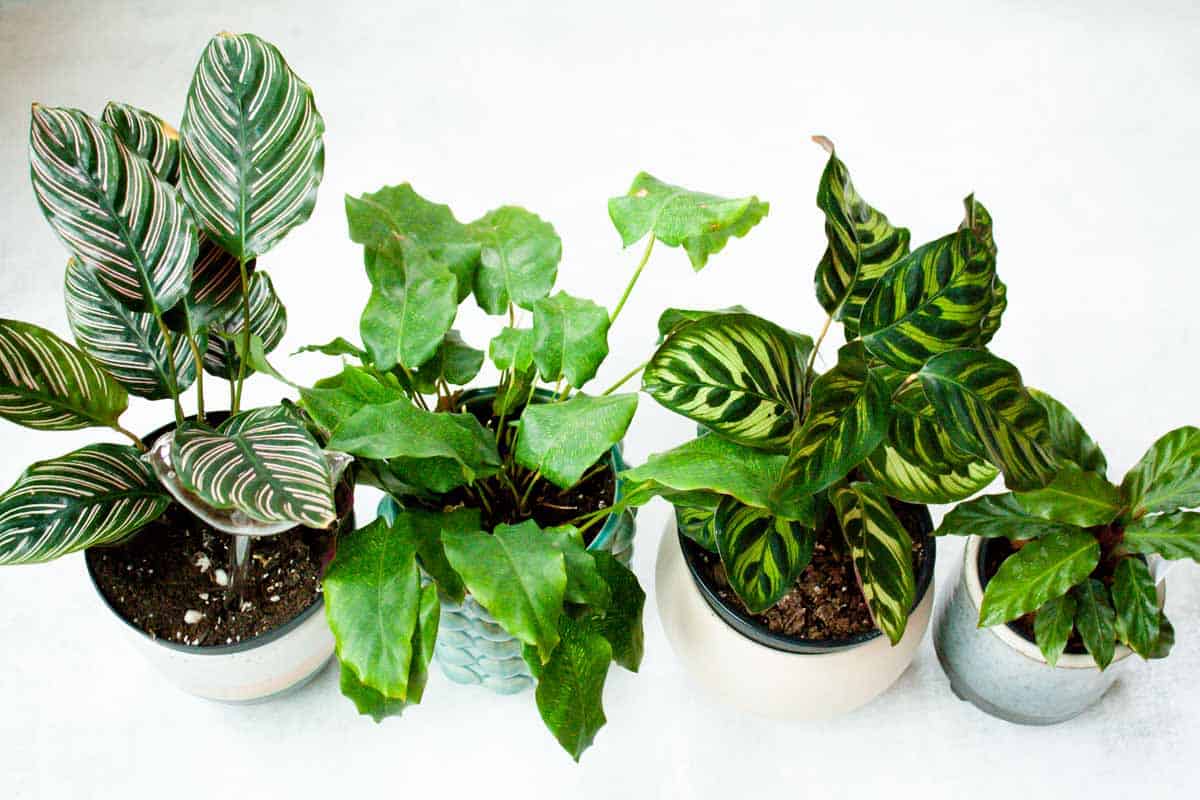
Why are my calathea leaves turning yellow?
This is generally a sign of overwatering. While calathea like consistently moist soil, they don’t like to have soggy roots. Slow down on the watering—the already-yellow leaves are going to stay that color, but this should stop more leaves from yellowing.
If slowing down on the watering doesn’t help, you’ll want to gently remove the plant from the pot and inspect the roots for root rot.
Why do the leaves have brown edges or brown spots?
It sounds like your plant is not happy with the quality of its water. Fluoride, the minerals in hard water, and even the temperature of the water can affect calathea leaves. Be sure you are using distilled water, rainwater or snow melt, or dechlorinated filtered tap water for your plants.

The tips of the leaves look all dry and crispy!
If your leaves are getting crispy at the tips, you need to add some more humidity to your calathea care routine. Check out the humidity section above for some easy ways to fix this.
Why are my calathea leaves curling?
Leaf curl is often a sign of low humidity or too hot of temperatures. Get that baby some moisture, or into a cooler spot!

Whether you’re drawn in by the intricate leaf patterns or the purple undersides, we hope you feel a bit more confident in calathea care when adding a new plant to your collection!
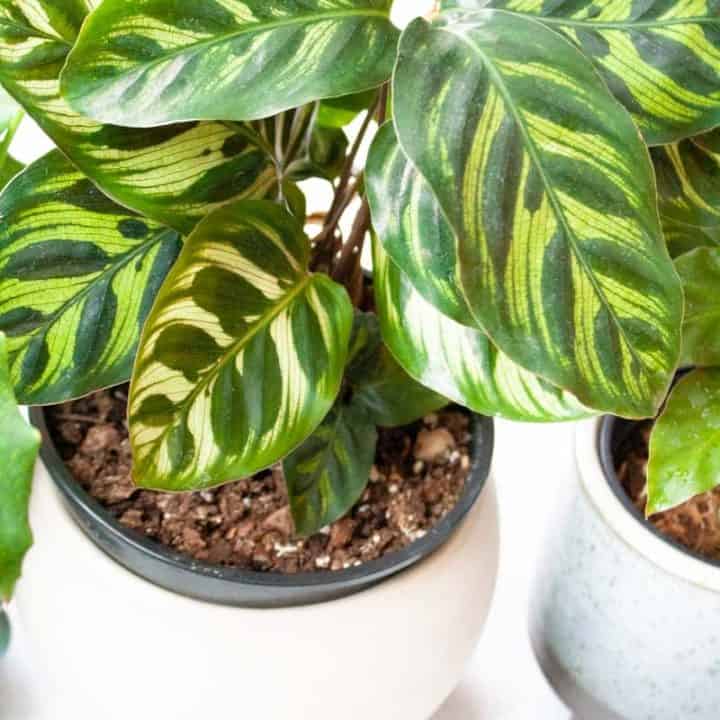
Calathea Care Quick Guide
Materials
- Calathea Plant
- Well-draining potting medium
Tools
- Container with a drainage hole
- Wooden chopstick for aeration
- Mister bottle (optional)
Instructions
- Avoid direct light. Bright direct sun will fade and burn your calathea. Stick to medium, indirect light.
- Water thoroughly. Water when the top inch of soil is dry, and slowly add water until you see it coming out of the drainage hole of the pot.
- Use the right water. Calathea is sensitive to the quality of its water. Stick with distilled water, rainwater, or filtered tap water that has been dechlorinated.
- Aerate often. Gently poke a wooden chopstick into the surface of the soil before watering on a regular basis. This will help air and water circulate and reach all of the roots.
- Keep it humid. Calathea thrive in humidity, and the leaves will curl or brown if the air is too dry. Use a humidifier, put the pot on a pebble tray, or group your plants together to boost the humidity.
- Mist regularly (optional). Misting doesn't do a ton to boost the humidity, but it does knock off pests that are trying to make your calathea home.
Notes
To dechlorinate water, allow it to sit on the counter in a clear container for at least 24 hours before using.

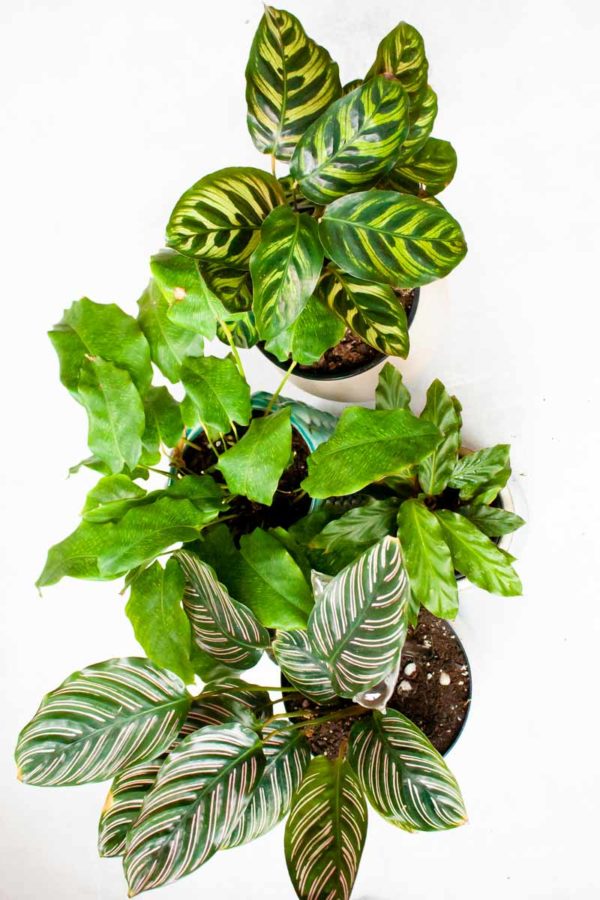






I have a healthy-looking calathea rattlesnake plant, but it has lines of holes in some of the leaves. Can you tell me what is causing this/what I should do? Thank you.
It is possible that it is a matter of low humidity, but I would also check for pests. Look at the underside of the leaves and the nooks on the stem where the petioles branch off closely (maybe even with a magnifying glass) to see if there is a pest issue.
This is helpful and easy to understand information. Thank you. I love my Peacock Plant, and it seems to be doing well, though since it is mid-winter in Minnesota, I didn’t expect it to be sending out so many new leaves. 👍🌟👍 Thank you.
Thank you so much, I really enjoyed reading about your plants I absolutely love mine and there’s a commercial in my way so I can’t see what I’m texting anyway thank you so much 😍😍😍